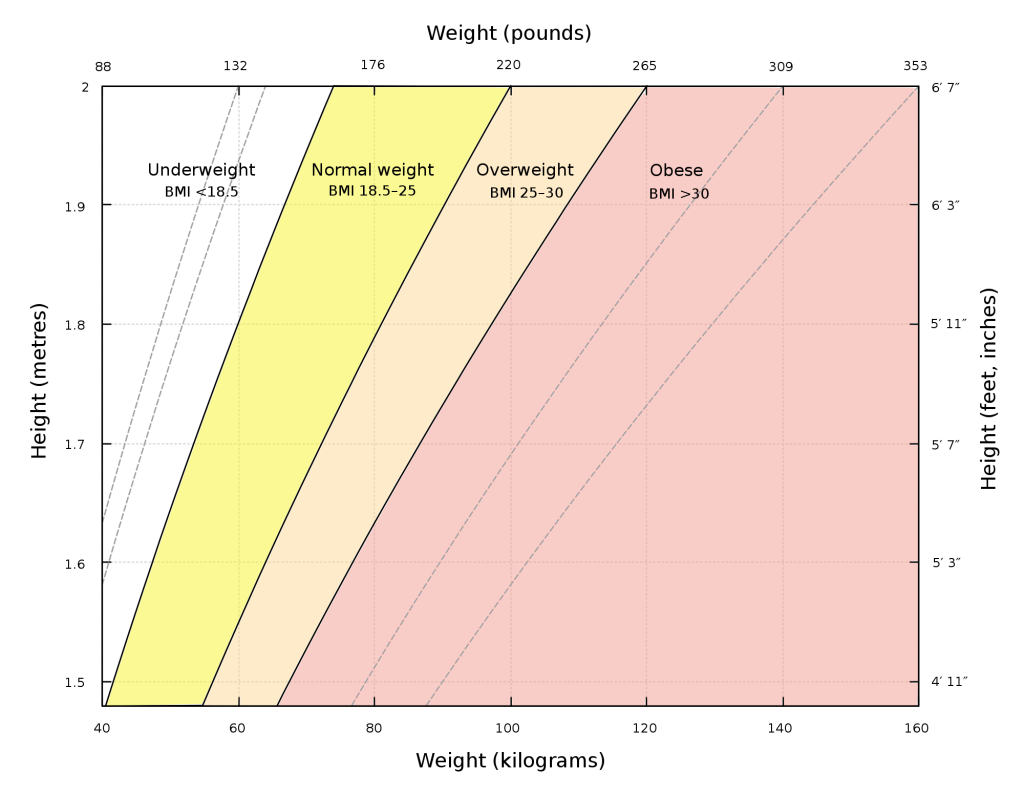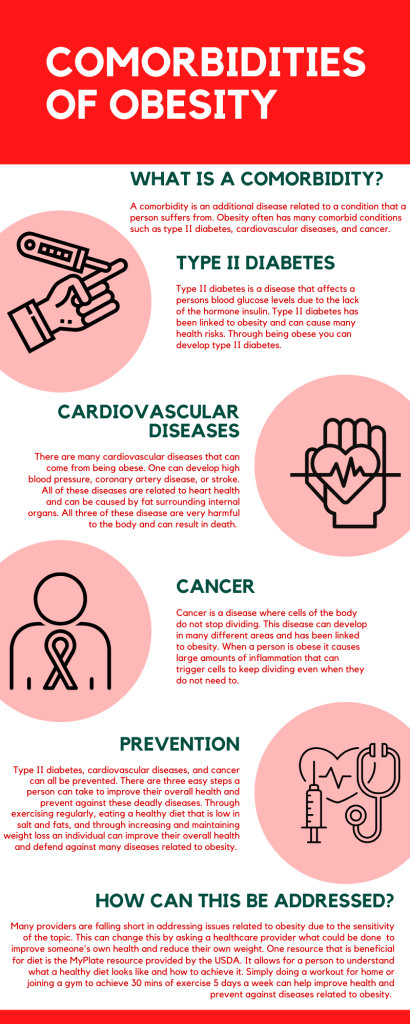8
Samuel Garrson
Body Mass Index
Obesity affects an individual’s health in many ways, including an increased risk of development of diseases. Who is classified as obese? A person is considered overweight or obese based on their height and weight, which is used to determine body mass index (BMI) (Apovian, 2016). An individual with a body mass index in the range of 25-30 is considered overweight. If an individual’s body mass index is 30 or higher, they are considered obese (Centers for Disease Control and Prevention [CDC], 2018).
 BMI chart, by amfucla is licensed under CC BY-SA
BMI chart, by amfucla is licensed under CC BY-SA
Being classified as obese or overweight greatly increases an individual’s chance to develop additional diseases called comorbidities (National Heart, Lung and Blood Institute & National Institute of Diabetes and Digestive and Kidney Diseases [NHLB & NIDDK], 1998). In this chapter, there will be a focus on three of the most common diseases that can develop from being obese: type II diabetes, cardiovascular diseases, and cancer.
Type II Diabetes
Diabetes is a disease that affects blood glucose (sugar) levels. There are two forms of diabetes, type I, which is an autoimmune disorder, and type II, which can develop due to genetics and behavior (NIDDK, 2016b). Insulin is a hormone created by the pancreas that moves glucose from the blood into cells to be used for energy (NIDDK, 2016b). Diabetes develops when insulin does not work properly (type II) or when there is not enough produced (type I) (NIDDK, 2016b). Both types result in high blood glucose levels, known as hyperglycemia (NIDDK, 2016b). For more information on the role of insulin visit: The Role Of Hormones.
“What is Diabetes? | Physiology | Biology | FuseSchool, by FuseSchool” by Global Education, is licensed under CC BY-NC.
Obesity is the number one cause of type II diabetes (Liu et al., 2015). Being overweight prevents insulin receptors from recognizing the amount of insulin in the blood, therefore not allowing excess glucose into the cells. This is called insulin resistance and it eventually causes damage to the pancreas, negatively affecting its ability to make insulin. Medical professionals recommend those with diabetes to follow strict guidelines of testing glucose levels, diet modifications, and possible medication. If individuals do not properly manage their blood sugar levels, they are at higher risk for developing many additional diseases, such as cardiovascular diseases, vision problems, foot disorders, and kidney disease (NIDDK, 2016b).
Cardiovascular Diseases
Obesity is a major risk factor for the cardiovascular system (which includes the heart, blood, and blood vessels) due to the added stress of supporting additional body mass. This excess weight can increase blood pressure, cholesterol levels, and place large amounts of fat around internal organs (Akil & Ahmad, 2011). Over time, conditions such as high blood pressure, stroke, coronary artery disease and congestive heart failure can develop.
High blood pressure, also known as hypertension, occurs when the blood pushes against the walls of the blood vessels with more force than normal (“High Blood Pressure,” n.d.). A person does not typically realize they have high blood pressure because there are no specific symptoms that can be detected without diagnostic testing (“High Blood Pressure,” n.d.). Uncontrolled high blood pressure increases the risk of a heart attack or congestive heart failure, both of which can lead to death. However, it can be treated with lifestyle changes or medications (“High Blood Pressure,” n.d.).
Coronary artery disease occurs when the blood vessels in the heart are damaged or blocked (Mayo Clinic, 2018). The major causes for developing coronary artery disease are cholesterol deposits or inflammation of the heart’s blood vessels (Mayo Clinic, 2018). If a person has high levels of blood cholesterol, the excess cholesterol binds to the vessel walls, known as arteriosclerosis, causing a blockage in the blood vessel or eventually a rupture (known as heart attack or cardiac arrest). Individuals with a high BMI or large amounts of fat around internal organs are at a higher risk of dying from coronary artery disease than those at a healthy weight (NHLB & NIDDK, 1998).
Stroke is a blockage or a rupture of a vessel that affects blood flow to the brain, which can cause brain damage or death (“Stroke,” n.d.). Signs of a stroke may include weakness on one side of the body, confusion, headache, slurred speech, trouble seeing, and lack of balance or coordination. If any of these signs are recognized, call 9-1-1 right away. Fast treatment can lessen the damage to the brain (“Stroke,” n.d.).
“Heart Disease | Health | Biology | FuseSchool, by FuseSchool” by Global Education, is licensed under CC BY-NC.
Cancer
Cancer can originate in any area of the body. Cell inflammation and cancer-causing agents (carcinogens) sometimes cause a cell to mutate into an abnormal cell. When abnormal cells continually grow, they can spread through into normal tissues causing destruction to organs and body system function (American Cancer Society [ACS], 2015). Although it is hard to determine what exactly causes cancer to develop, there is a higher percentage of cancer in obese individuals. Some research has shown that excess weight causes continual levels of inflammation, which can lead to cancer by causing DNA damage within cells (National Cancer Institute [NCI], 2017).
“What Is Cancer? | Genetics | Biology | FuseSchool, by FuseSchool” by Global Education is licensed under CC BY-NC.
Prevention and Treatment
All of these conditions have similar lifestyle prevention methods. An individual’s chance of developing these comorbid conditions can be reduced through weight loss, increasing physical activity to at least 30 minutes for five days a week, and improving diet (NIDDK, 2016a). Prevention and treatment for high blood pressure also includes reducing the amount of salt consumed (“High Blood Pressure,” n.d.). A helpful resource for improving diet and achieving a healthier lifestyle is the MyPlate guidelines, developed by the United States Department of Agriculture (USDA). It allows individuals to understand what a healthy diet looks like and helps them achieve such a diet in their own life.
MyPlate can be accessed here: https://www.choosemyplate.gov/
Also, visit “Food and Calories” to better understand how to choose healthy foods.
Treatments vary for each of these comorbid conditions. If a person is concerned that they may be at risk for one of these conditions, consult a health care professional for treatment options that may include medication or behavior modifications. In some cases, due to time constraints or fear of offending an overweight individual, health care providers do not always address behavior modifications. Losing weight is a necessary component of stopping these diseases from damaging the body. Refer to the chapter “The Line Between Body Positivity and Glorifying Obesity” to learn more about when health professionals are avoiding conversations with obese patients.
Summary
As rates of comorbidities linked to obesity rise, it has been found that not many healthcare providers are giving advice for changing lifestyle choices to improve weight (Grabovac et al., 2019). There needs to be more of an emphasis on improving healthy lifestyles both from individuals themselves and health providers so that chronic disease rates can be reduced or avoided. The infographic below is a summary of the comorbid conditions discussed in this chapter.

Review Questions
1. An individual’s risk for stroke increases as _______ increases. (Fill in the blank)
References
Akil, L. & Ahmad, H. A. (2011). Relationships between obesity and cardiovascular diseases in four southern states and Colorado. Journal of Health Care for the Poor and Underserved, 22(4 Suppl), 61–72. doi:10.1353/hpu.2011.0166
American Cancer Society. (2015, December 8). What Is Cancer?. https://www.cancer.org/cancer/cancer-basics/what-is-cancer.html
Apovian, C. M. (2016). Obesity: Definition, comorbidities, causes, and burden. http://libproxy.clemson.edu/login?url=http://search.ebscohost.com/login.aspx?direct=true&db=mnh&AN=27356115
Centers for Disease Control and Prevention. (2018, August 13). Adult obesity facts. https://www.cdc.gov/obesity/data/adult.html
Grabovac, I., Smith, L., Stefanac, S., Haider, S., Cao, C., Waldhoer, T., Jackson, S., Yang, L. (2019). Health care providers’ advice on lifestyle modification in the US population: Results from the NHANES 2011-2016. Excerpta Medica. doi:10.1016/j.amjmed.2018.11.021
Liu, A. Y., Silvestre, M. P., & Poppitt, S. D. (2015). Prevention of type 2 diabetes through lifestyle modification: Is there a role for higher-protein diets?. American Society for Nutrition. doi:10.3945/an.115.008821
Mayo Clinic. (2018, May 16). Coronary artery disease. https://www.mayoclinic.org/diseases-conditions/coronary-artery-disease/symptoms-causes/syc-20350613
National Cancer Institute. (2017, January 17). Obesity and Cancer. https://www.cancer.gov/about-cancer/causes-prevention/risk/obesity/obesity-fact-sheet
National Heart, Lung and Blood Institute, National Institute of Diabetes and Digestive and Kidney Diseases (1998). Clinical guidelines on the identification, evaluation, and treatment of overweight and obesity in adults: The evidence report. National Institutes of Health. https://www.nhlbi.nih.gov/files/docs/guidelines/ob_gdlns.pdf
National Heart, Lung, and Blood Institute. (n.d.). High Blood Pressure. https://www.nhlbi.nih.gov/health-topics/high-blood-pressure
National Heart, Lung, and Blood Institute. (n.d.). Stroke. https://www.nhlbi.nih.gov/health-topics/stroke
National Institute of Diabetes and Digestive and Kidney Diseases. (2016a). Preventing type 2 diabetes. https://www.niddk.nih.gov/health-information/diabetes/overview/preventing-type-2-diabetes
National Institute of Diabetes and Digestive and Kidney Diseases. (2016b). What is diabetes. https://www.niddk.nih.gov/health-information/diabetes/overview/what-is-diabetes
a condition characterized by the excessive accumulation and storage of fat in the body
a measure of body fat that is the ratio of the weight of the body in kilograms to the square of its height in meters
existing simultaneously with and usually independently of another medical condition.
a common form of diabetes mellitus that develops especially in adults and most often in obese individuals and that is characterized by hyperglycemia resulting from impaired insulin utilization coupled with the body's inability to compensate with increased insulin production.
a malignant tumor of potentially unlimited growth that expands locally by invasion and systemically by metastasis.
of, relating to, or caused by autoantibodies or T cells that attack molecules, cells, or tissues of the organism producing them
abnormally high blood pressure and especially arterial blood pressure
sudden diminution or loss of consciousness, sensation, and voluntary motion caused by rupture or obstruction (as by a clot) of a blood vessel of the brain
a condition and especially one caused by atherosclerosis that reduces blood flow through the coronary arteries to the heart and typically results in chest pain or heart damage
heart failure in which the heart is unable to maintain adequate circulation of blood in the bodily tissues or to pump out the venous blood returned to it by the veins
a method of identifying a disease from its signs and symptoms
a steroid alcohol C27H45OH that is present in animal cells and body fluids, regulates membrane fluidity, and functions as a precursor molecule in various metabolic pathways and as a constituent of LDL may cause atherosclerosis.
a local response to cellular injury that is marked by capillary dilatation, leukocytic infiltration, redness, heat, and pain and that serves as a mechanism initiating the elimination of noxious agents and of damaged tissue.
a chronic disease characterized by abnormal thickening and hardening of the arterial walls with resulting loss of elasticity
any of various nucleic acids that are usually the molecular basis of heredity, are constructed of a double helix held together by hydrogen bonds between purine and pyrimidine bases (see BASE entry 1 sense 6b) which project inward from two chains containing alternate links of deoxyribose and phosphate, and that in eukaryotes are localized chiefly in cell nuclei.
